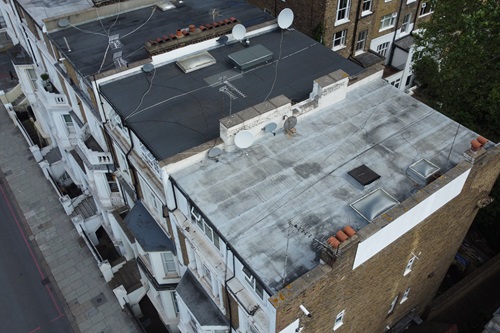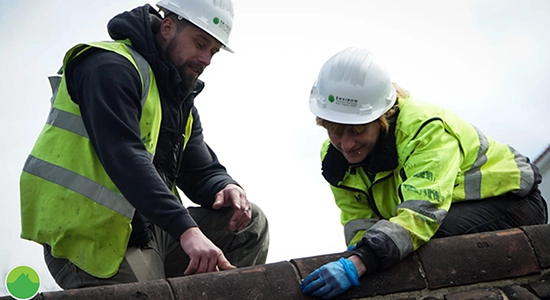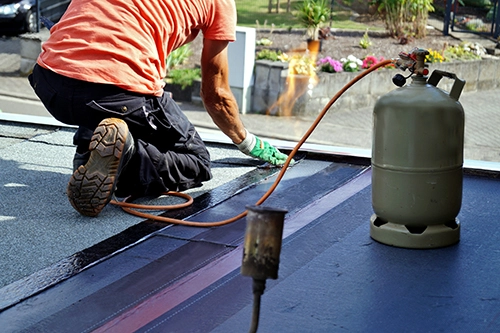- About Us
- Services
- Blog
- Contact
Need a quote?
Flat roofing in London is often the most popular choice for new extensions, garages, commercial buildings, and certain types of homes. Known for giving a building a modern style, a flat roof offers clean lines and a sleek profile. Of course, the term ‘flat’ is a slight misnomer as these types of roofs are not entirely flat: good roofing companies in London will ensure they are constructed on a subtle, almost imperceptible slope.




This is to ensure rainwater doesn’t build up in certain areas where it could pool and cause damage. Unlike in the past, this type of roof is now far more durably constructed and will last for decades with the usual routine maintenance.
If you are interested in a flat roof for your property, read on. We’ll discuss the advantages and how you can ensure you choose a quality roofing firm to help you construct or upgrade a flat roof.
Maintenance of a flat roof is much simpler than on a pitched roof, and any damage is typically much easier (and therefore cheaper) to find and repair. Cleaning gutters is more straightforward, reducing the expense of roof cleaning and maintenance. Having said that, it is important that your flat roof is cleaned regularly to avoid any build-up of debris which can cause structural damage if left to sit for long periods. You should also take proactive action to check for damage after periods of bad weather and have issues fixed as soon as they appear.
Roofing companies in London can help with all this if you are unable to tackle it yourself. Flat roofs can even be coated with UV resistant paint to prevent natural damage from the sun. But when properly looked after, this kind of roof can endure for many years with little in the way of maintenance required.
One very attractive feature of flat roofs is that the installation cost is significantly lower than other roof types, both in terms of time and money. Flat roofs require far less in the way of materials and also take less time to construct. Smaller installations can be wrapped up in just a couple of days or even less.

It depends on the construction, but the minimum weight a flat roof must be capable of bearing is 300lbs. This refers to a concentrated weight where a load is positioned on just one area of the roof. So, for example, a commercial flat roof can approximately support a 300lb HVAC unit in a 2.5×2.5ft single space.
If you opt for a flat roof anywhere on your property, remember that it comes with a need for proper maintenance. Low-slope roofing London-wide should be checked every six months or so, or after spells of bad weather, to spot any signs of damage. No matter how small, these should be addressed before they escalate. Remove any debris (leaves, twigs and so on) regularly to avoid these blocking the gutters and allowing water to pool and stand on the roof.
If there are trees in the close vicinity, keep them cut back to reduce the amount of foliage that falls on your flat roof. And check internally for signs of moisture, dampness or water damage on a regular basis. Spotting problems early means resolving them will be cheaper in the long run.

Building a flat roof can be done in three ways. The simplest and most cost-effective choice for levelled roofing London-wide is to construct a warm roof where a roofing membrane is placed over the insulation that keeps the timber structure warm. Another option is to create a cold roof where insulation is positioned between the rafters under the ply roof covering. This is commonly applied to flat-roofed extensions.
The third method is the hybrid roof that contains diverse elements. Their designs require a gap of ventilation above a warm roof to prevent excess moisture within the roof structure.
If you’re looking for flat roofing local contractors, don’t just select the first firm you come across. Find a roofing company that’s been in business for a while and can demonstrate a good track record in installing, repairing, and replacing flat roofs specifically. Ask for recommendations from your own network or from a local trade association. If you need refurbishment work done to 50% or more of your roof, you’ll need a roofing contractor who can self-certify their work under the Competent Person Scheme. Otherwise, the Building Control department at your local authority will need to approve the job before it begins.
Ask whether they are covered by liability insurance and how long they’ll guarantee the work they will carry out. And never just opt for the cheapest quote unless you’re quite sure they’re the best company for the job. You can’t afford to compromise on your roof as the structural integrity of your property depends on it.
Ensuring your flat roof will comply with building regulations before installation can save property owners time, money and stress. First, the roof must have a slope of around 1:80, with water draining away to one or two roof edges. Waterproofing must be extended up to the adjacent walls with at least 150 mm from the surface of the roof.
Contractors must install ventilation in cold roofs. For warm roofs, the deck must be bonded with a VCL. The roof should have the capacity to withstand strong winds and be sturdy enough to take an individual’s weight. Finally, check whether planning permission is needed. Typically, this is only required if you live in a conservation area or a listed building, or are making significant changes to an existing roof.
If you’re looking for top roofing solutions at competitive rates, check out our range of roofing services at Environ Roofing Company London. To get started, call one of our representatives today!

